Kiedy organizacja decyduje się na przyjęcie Scrum, jedną z pierwszych rzeczy do zrozumienia jest to, jak role Scrum różnią się od tradycyjnych ról w realizacji projektów. W Scrumie występują dwa zestawy ról:
Rola wewnętrzna
- Właściciel produktu — ma wizję produktu
- Scrum Master — pomaga zespołowi najlepiej wykorzystać Scrum do budowy produktu
- Zespół deweloperski — buduje produkt
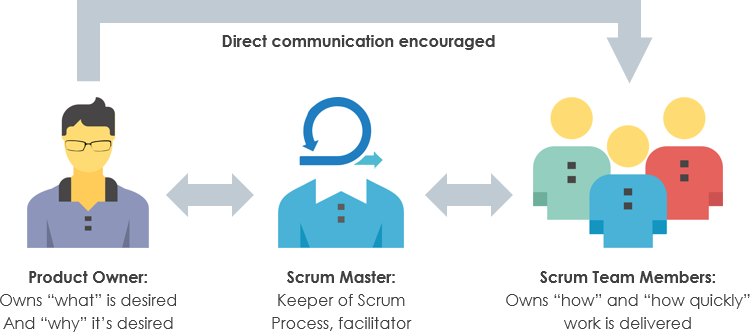
Rola zewnętrzna
- Właściciel biznesu
- Interesariusz (tj. użytkownicy końcowi i eksperci dziedzinowi)
- itd.
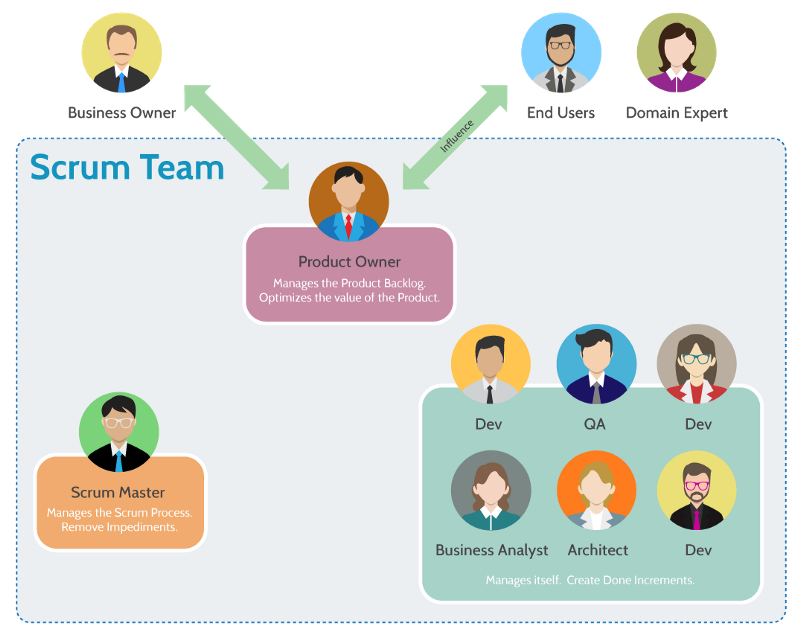
Czym jest zespół Scrum?
Zespół Scrum (powszechnie nazywany „Zespołem”) jest mały (od 3 do 9 osób, nie licząc Scrum Mastera i Właściciela Produktu), współlokalizowany (przynajmniej wirtualnie), samoorganizujący się, samodzielny, zorientowany na wartość, pełnoetatowa grupa ludzi, zwana po prostu członkami zespołu. Niektóre z tych terminów wymagają wyjaśnienia:
Samoorganizujący się:Samoorganizujący się zespół to taki, który wybiera, jak najlepiej wykonać swoją pracę, zamiast być kierowanym (mikrozarządzanym) przez innych spoza zespołu. Ponieważ członkowie zespołu pracują razem, ułatwia to naukę i motywuje zespół do przejęcia odpowiedzialności za swój proces.
Zespół wielofunkcyjny:Zespół wielofunkcyjny to taki, który posiada całą wiedzę i umiejętności niezbędne do osiągnięcia swoich celów i zadań, co pozwala mu zakończyć swoją pracę bez pomocy zewnętrznej.
Zorientowany na wartość:Członkowie zespołu cenią sobie pracę zespołową; nieustannie poprawiają siebie, swój zespół, swoje otoczenie i narzędzia; dążą do posiadania osobistych wartości, takich jak otwartość, koncentracja, zaangażowanie, szacunek i odwaga.

Role Scrum
Nasza podróż zaczyna się od ogólnego opisu samego zespołu Scrum, przechodzi do omówienia trzech ról wewnątrz zespołu (Właściciel Produktu, Scrum Master i Zespół Deweloperski) i kończy opisem ról na zewnątrz zespołu (Właściciel Biznesu, Interesariusze i Eksperci Tematyczni).
Role wewnętrzne
Właściciel Produktu
Każdy członek zespołu Scrum pełni rolę członka zespołu, ale tylko jeden członek zespołu ponosi odpowiedzialność przed biznesem za sukces zespołu Scrum i wartość wyników zespołu Scrum. To Właściciel Produktu, w skrócie PO. A ta odpowiedzialność jest bardzo ważna — określa PO jako formalnego lidera zespołu w oczach świata zewnętrznego.
Właściciel Produktu jest jedyną osobą odpowiedzialną za zarządzanie backlogiem produktu. Zarządzanie backlogiem produktu obejmuje:
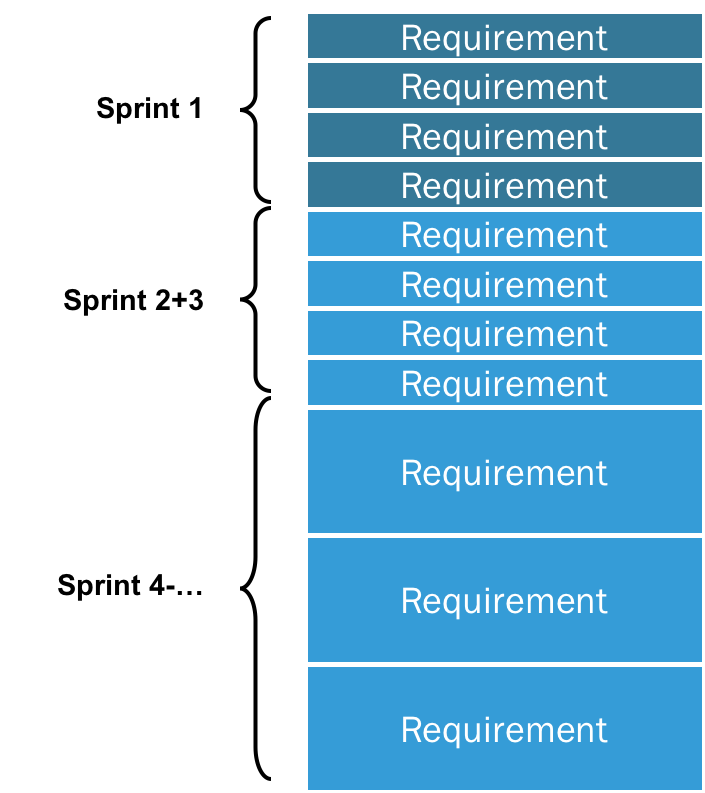
- Jasne wyrażanie elementów backlogu produktu.
- Porządkowanie elementów w backlogu produktu w celu najlepszego osiągnięcia celów i misji.
- Optymalizacja wartości pracy wykonywanej przez zespół deweloperski.
- Zapewnienie, że backlog produktu jest widoczny, przejrzysty i jasny dla wszystkich oraz pokazuje, nad czym zespół Scrum będzie pracować następnie.
- Zapewnienie, że zespół deweloperski rozumie elementy w backlogu produktu na potrzebnym poziomie.
PO jest oczami i uszami zespołu Scrum w świecie zewnętrznym (wobec interesariuszy). Jest jedynym punktem formalnego kontaktu zespołu Scrum, przewodnikiem informacji. Dodajmy do tego, że PO wspiera zespół Scrum. Oznacza to, że ponosząc odpowiedzialność za wyniki zespołu Scrum, PO jest zaabsorbowany zapewnieniem, że zespół Scrum otrzymuje odpowiednie informacje zwrotne, aby stworzyć odpowiedni produkt w odpowiednim tempie. PO spędza dużo czasu na określaniu zakresu produktu, wyjaśnianiu niejasnych oczekiwań, negocjowaniu terminów dostaw i dostosowywaniu wszystkiego do zespołu Scrum.
Powinniśmy również zauważyć, że chociaż słowo 'Właściciel’ znajduje się w tytule, PO może nie być ekspertem produktu. Owszem, PO ma wiele wiedzy i umiejętności, ale rola jest definiowana przez odpowiedzialność, a nie przez umiejętności specyficzne dla produktu. Dobry PO zdaje sobie sprawę, że może istnieć bogactwo inteligencji zarówno wewnątrz, jak i na zewnątrz zespołu Scrum i wie, jak to wykorzystać zarówno dla dobra zespołu Scrum, jak i dla dobra produktu.
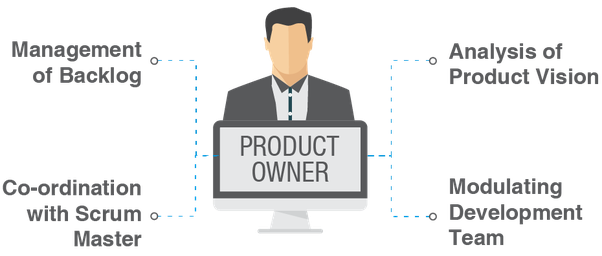
Scrum Master
Scrum Master, podczas gdy PO jest oczami i uszami w kierunku świata zewnętrznego, w wielu aspektach oczy i uszy Scrum Mastera są zdecydowanie skierowane do wewnątrz, co obejmuje następujące role:
- Scrum Master jest nieformalnym liderem zmartwionym tym, co dzieje się wewnętrznie w zespole Scrum i dbającym o to, aby Scrum był używany poprawnie.
- Scrum Master jest liderem bez odpowiedzialności menedżerskich. Raczej koncentruje się na zdrowiu zespołu Scrum i ciągłym doskonaleniu zespołu Scrum, szczególnie jeśli chodzi o wykorzystanie Scrum przez zespół Scrum.
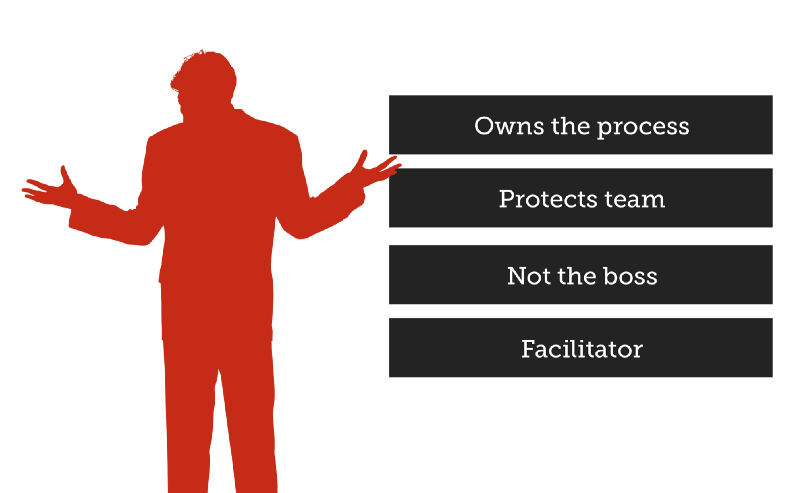
Role, które pełni Scrum Master
Usługa dla Właściciela Produktu
Scrum Master wspiera Właściciela Produktu na kilka sposobów, w tym:
- Zapewnienie, że cele, zakres i dziedzina produktu są zrozumiane przez wszystkich w zespole Scrum w możliwie najlepszy sposób.
- Znajdowanie technik efektywnego zarządzania backlogiem produktu.
- Pomoc zespołowi Scrum w zrozumieniu potrzeby jasnych i zwięzłych elementów backlogu produktu.
- Zrozumienie planowania produktu w środowisku empirycznym.
- Zapewnienie, że Właściciel Produktu wie, jak uporządkować backlog produktu, aby zmaksymalizować wartość.
- Zrozumienie i praktykowanie zwinności.
- Facylitowanie wydarzeń Scrum na żądanie lub w razie potrzeby.
Usługa Scrum Mastera dla Zespołu Rozwojowego
Scrum Master wspiera Zespół Rozwojowy na kilka sposobów, w tym:
- Coaching Zespołu Rozwojowego w zakresie samoorganizacji i wielofunkcyjności.
- Pomoc Zespołowi Rozwojowemu w tworzeniu produktów o wysokiej wartości.
- Usuwanie przeszkód w postępach Zespołu Rozwojowego.
- Facylitowanie wydarzeń Scrum na żądanie lub w razie potrzeby.
- Coaching Zespołu Rozwojowego w środowiskach organizacyjnych, w których Scrum nie jest jeszcze w pełni przyjęty i zrozumiany.
Usługa Scrum Mastera dla Organizacji
Scrum Master wspiera organizację na kilka sposobów, w tym:
- Prowadzenie i coaching organizacji w zakresie przyjęcia Scruma;
- Planowanie wdrożeń Scruma w organizacji;
- Pomoc pracownikom i interesariuszom w zrozumieniu i wdrażaniu Scruma oraz empirycznego rozwoju produktu;
- Wprowadzanie zmian, które zwiększają produktywność Zespołu Scrum; oraz,
- Współpraca z innymi Scrum Masterami w celu zwiększenia efektywności stosowania Scruma w organizacji.
Zespół Rozwojowy
Zespół Rozwojowy Termin „Zespół Rozwojowy” jest używany do reprezentowania części Zespołu Scrum, która aktualnie rozwija lub tworzy Produkt — i może, ale nie musi, obejmować PO i SM. Całkowicie właściwe, a często użyteczne, jest, aby PO i SM byli w Zespole Rozwojowym, ale muszą zawsze zdawać sobie sprawę, że ich role przywódcze są najważniejsze.
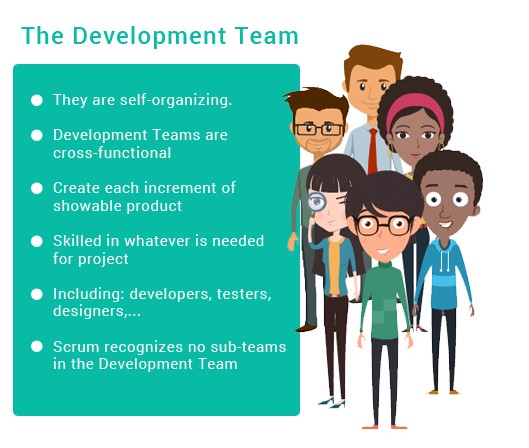
Role zewnętrzne
Interesariusze są celem, dla którego produkt lub usługa jest tworzona w pierwszej kolejności. Interesariusze to osoby, które mają określone potrzeby, pragnienia i życzenia; w związku z tym w terminach biznesowych mają określone wymagania, które muszą być spełnione.
Scrum definiuje interesariuszy jako osoby, które nie są częścią zespołu Scrum. Odpowiedzialnością Zespołu Scrum jest spełnienie wymagań interesariuszy i zaspokojenie ich.
Zauważ, że:
Zazwyczaj interesariusze nie mają jasnego zrozumienia tego, czego potrzebują, a nawet jeśli mają, często zmieniają zdanie. Zazwyczaj ustalenie rzeczywistych potrzeb interesariusza osiąga się poprzez wiele spotkań z interesariuszami oraz po wielu próbach i błędach.
Inne Artykuły podstawowe Związane z rolami Scrum:
- Czym jest Zespół Scrum?
- Czym jest Zespół Samoorganizujący się w Scrum?
- Jak działa Zespół Scrum? — Krótki przewodnik
- Jak być dobrym Właścicielem Produktu w projekcie Scrum?
- Jaka jest rola Właściciela Produktu w Scrum?
- Zwinny rozwój: Jak zostać wykwalifikowanym Scrum Masterem?
- Czym są Świnia i Kurczak w Scrum?
- Kierownik projektu vs Scrum Master vs Właściciel projektu
- Jakie są trzy role Scrum?
- Kim jest Scrum Master? Rola i odpowiedzialności
- Czym jest Zespół Wielofunkcyjny w Agile?
Ten post dostępny jest również w Deutsch, English, Español, فارسی, Français, Bahasa Indonesia, 日本語, Portuguese, Ру́сский, Việt Nam, 简体中文 and 繁體中文













